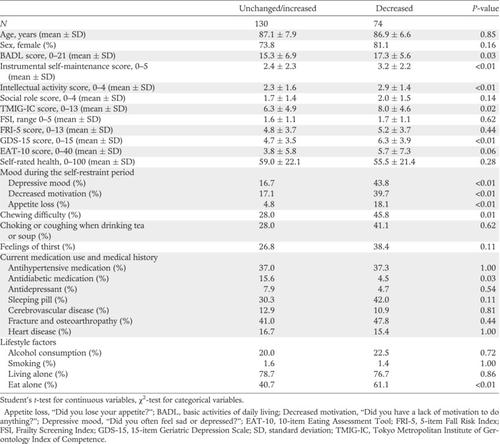当前位置:
X-MOL 学术
›
Geriatr. Gerontol. Int.
›
论文详情
Our official English website, www.x-mol.net, welcomes your feedback! (Note: you will need to create a separate account there.)
Association of decreased frequency of conversation with depression, oral function and eating alone: A cross‐sectional study of older adults during the COVID‐19 pandemic
Geriatrics & Gerontology International ( IF 3.3 ) Pub Date : 2024-02-24 , DOI: 10.1111/ggi.14832 Yasuko Ishimoto 1 , Yumi Kimura 2 , Taizo Wada 3, 4 , Kiichi Hirayama 5 , Emiko Kato 4 , Mai Tatsuno 4 , Michiko Fujisawa 4 , Yoriko Kasahara 6 , Masahiro Nakatsuka 7 , Mitsuhiro Nose 4 , Masanori Iwasaki 8, 9 , Satoko Kakuta 10 , Mayumi Hirosaki 4 , Kiyohito Okumiya 4 , Kozo Matsubayashi 4 , Ryota Sakamoto 4, 5
Geriatrics & Gerontology International ( IF 3.3 ) Pub Date : 2024-02-24 , DOI: 10.1111/ggi.14832 Yasuko Ishimoto 1 , Yumi Kimura 2 , Taizo Wada 3, 4 , Kiichi Hirayama 5 , Emiko Kato 4 , Mai Tatsuno 4 , Michiko Fujisawa 4 , Yoriko Kasahara 6 , Masahiro Nakatsuka 7 , Mitsuhiro Nose 4 , Masanori Iwasaki 8, 9 , Satoko Kakuta 10 , Mayumi Hirosaki 4 , Kiyohito Okumiya 4 , Kozo Matsubayashi 4 , Ryota Sakamoto 4, 5
Affiliation

|
AimThis study examined the associations between geriatric factors and decreased opportunities for conversation among older adults amid a period of self‐restraint during the COVID‐19 pandemic.MethodsA cross‐sectional questionnaire‐based survey was carried out in October 2020. The participants were 204 residents aged ≥65 years staying at a private care home in Kyoto city, Japan. Logistic regression analysis was carried out with the reduction of conversation opportunities as the dependent variable, and geriatric factors as independent variables after adjusting for age and sex. We compared the decreased frequency of opportunities between residents in the assisted living wing and in the nursing care wing of the private care home.ResultsThe percentages of respondents who reported a decrease in the opportunities for conversation among themselves were 43.9% for residents in the assisted living wing and 19.7% for those in the nursing care wing. After adjusting for age and sex, the opportunities for conversation was significantly associated with the basic activities of daily living (OR 1.07, 95% CI 1.01–1.12), instrumental self‐maintenance (OR 1.25, 95% CI 1.08–1.46), intellectual activity (OR 1.35, 95% CI 1.09–1.66), depression (OR 1.13, 95% CI 1.04–1.23), depressive mood (OR 3.83, 95% CI 1.98–7.42), decreased motivation (OR 3.11, 95% CI 1.58–6.12), appetite loss (OR 4.32, 95% CI 1.54–12.07), swallowing function (OR 1.05, 95% CI 1.00–1.10), chewing difficulty (OR 2.50, 95% CI 1.31–4.75) and eating alone (OR 2.5, 95% CI 1.35–4.62).ConclusionDecreased opportunities for conversation was more perceived among older adults with higher daily functioning, suggesting that it is associated with depressed mood, oral function and solitary eating. Geriatr Gerontol Int 2024; ••: ••–••.
中文翻译:

谈话频率减少与抑郁、口腔功能和单独进食的关系:一项针对 COVID-19 大流行期间老年人的横断面研究
目的本研究探讨了老年因素与 COVID-19 大流行期间自我克制时期老年人交谈机会减少之间的关联。方法于 2020 年 10 月进行了一项横断面问卷调查。参与者为 204 名居民年龄≥65岁,住在日本京都市的私人护理院。调整年龄和性别后,以交谈机会减少为因变量,老年因素为自变量进行Logistic回归分析。我们比较了私人护理院的辅助生活区和护理区的居民之间的机会减少频率。结果对于辅助生活区的居民来说,表示彼此之间交谈机会减少的受访者比例为 43.9%翼和护理翼的人员为 19.7%。调整年龄和性别后,交谈的机会与日常生活的基本活动(OR 1.07,95% CI 1.01–1.12)、工具性自我维护(OR 1.25,95% CI 1.08–1.46)、智力显着相关。活动(OR 1.35,95% CI 1.09–1.66)、抑郁(OR 1.13,95% CI 1.04–1.23)、抑郁情绪(OR 3.83,95% CI 1.98–7.42)、动力下降(OR 3.11,95% CI 1.58) –6.12)、食欲减退(OR 4.32,95% CI 1.54–12.07)、吞咽功能(OR 1.05,95% CI 1.00–1.10)、咀嚼困难(OR 2.50,95% CI 1.31–4.75)和单独进食(OR 2.5, 95% CI 1.35–4.62)。结论 日常功能较高的老年人更容易感觉到交谈机会的减少,这表明这与情绪低落、口腔功能和单独进食有关。老年老年国际 2024;••:••–••。
更新日期:2024-02-24
中文翻译:

谈话频率减少与抑郁、口腔功能和单独进食的关系:一项针对 COVID-19 大流行期间老年人的横断面研究
目的本研究探讨了老年因素与 COVID-19 大流行期间自我克制时期老年人交谈机会减少之间的关联。方法于 2020 年 10 月进行了一项横断面问卷调查。参与者为 204 名居民年龄≥65岁,住在日本京都市的私人护理院。调整年龄和性别后,以交谈机会减少为因变量,老年因素为自变量进行Logistic回归分析。我们比较了私人护理院的辅助生活区和护理区的居民之间的机会减少频率。结果对于辅助生活区的居民来说,表示彼此之间交谈机会减少的受访者比例为 43.9%翼和护理翼的人员为 19.7%。调整年龄和性别后,交谈的机会与日常生活的基本活动(OR 1.07,95% CI 1.01–1.12)、工具性自我维护(OR 1.25,95% CI 1.08–1.46)、智力显着相关。活动(OR 1.35,95% CI 1.09–1.66)、抑郁(OR 1.13,95% CI 1.04–1.23)、抑郁情绪(OR 3.83,95% CI 1.98–7.42)、动力下降(OR 3.11,95% CI 1.58) –6.12)、食欲减退(OR 4.32,95% CI 1.54–12.07)、吞咽功能(OR 1.05,95% CI 1.00–1.10)、咀嚼困难(OR 2.50,95% CI 1.31–4.75)和单独进食(OR 2.5, 95% CI 1.35–4.62)。结论 日常功能较高的老年人更容易感觉到交谈机会的减少,这表明这与情绪低落、口腔功能和单独进食有关。老年老年国际 2024;••:••–••。



























 京公网安备 11010802027423号
京公网安备 11010802027423号